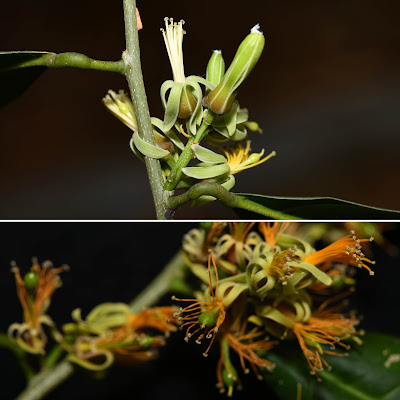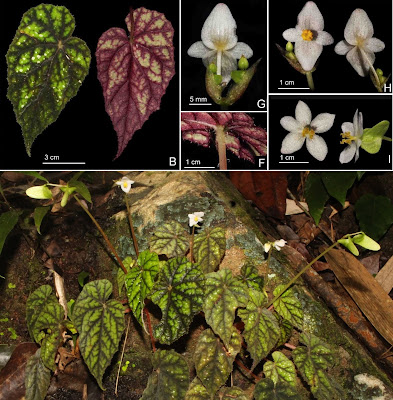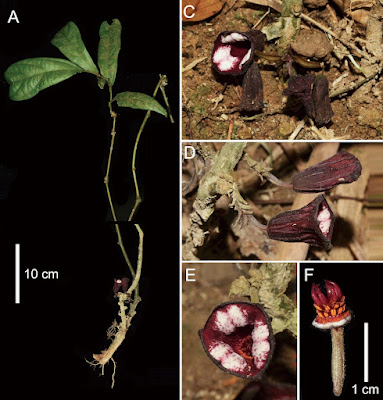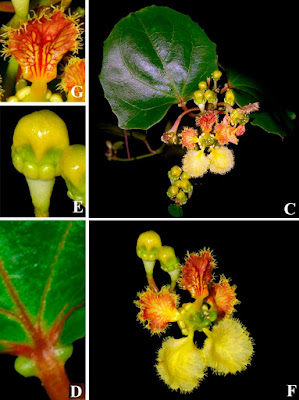[Most Recent Entries] [Calendar View]
Saturday, August 21st, 2021
| Time | Event | ||||
| 5:03p | [Botany • 2021] Stixis yingjiangensis (Resedaceae) • A New Species from Yunnan, China
Abstract Stixis yingjiangensis (Resedaceae), a new species from Yingjiang, Yunnan, China, is described and illustrated. It is compared with two morphologically similar species S. philippinensis, and S. villiflora. It differs from the two species by both surfaces with sparsely strigillose on lateral nerves, midrib and pustules (each pustule is formed by a multicellular cushion from which one short hair can also be produced), inflorescences axillary, racemes, 3–9 cm, filaments lower third pubescent, upper two thirds glabrous, androgynophores 2–3 mm, glabrous except apex sparsely puberulent, gynophores with densely white hairs, ovary glabrous. A complete morphological description of Stixis yingjiangensis is provided, together with photographs, a conservation assessment, and a diagnostic key to 4 species and 1 subspecies of Stixis from China. Keyword: China, new species, Resedaceae, Stixis philippinensis, Stixis yingjiangensis, Stixis villiflora, Yunnan
Stixis yingjiangensis J. Y. Shen sp. nov. 盈江斑果藤 Diagnosis: In terms of morphology, Stixis yingjiangensis exhibits morphology similar to S. philippinensis (Turcz.) Merr. and S. villiflora J.Y. Shen, S. Landrein, W.G. Wang & X.D. Ma, both of which calyx are reflexed at anthesis and with long gynophores (longer than 6 mm), but can be distinguished from them by several characters (See Table 1). S. yingjiangensis both leaf surfaces with sparsely strigillose on lateral nerves, midrib and pustules (each pustule is formed by a multicellular cushion from which one short hair can also be produced), while in S. philippinensis both surfaces glabrous except for a few pustules (without any hairs on it) above near the base of the midrib, and in S. villiflora both surfaces pubescent and pustulate (each pustule is formed by a multicellular cushion from which one to several hairs can also be produced), inflorescences axillary, racemes, 3–9 cm (vs. terminal, panicle, up to 25 cm long in S. philippinensis, axillary or terminal, racemes, 5–12 cm in S. villiflora), stamens 15–22, filaments lower third pubescent, upper two thirds glabrous (vs. 35–40(– 48), filaments glabrous in S. philippinensis, 14–18, filaments lower half pubescent, upper half sparsely pubescent or glabrous in S. villiflora), androgynophore 2– 4 mm, glabrous except apex sparsely puberulent (vs. 2–3 mm glabrous in S. philippinensis, ca. 1mm, lower half glabrous, upper half tomentose in S. villiflora), ovary glabrous (vs. glabrous in S. philippinensis, densely white hairs in S. villiflora). Etymology: The specific epithet is derived from the type locality, Yingjiang County, Dehong Dai and Jingpo Autonomous Prefecture, Yunnan, China. Jian-Yong Shen, Xing-Da Ma, Qiang-Bang Gong, Guo-Hui Huang, Xue-Lian Yang and Ji-Pu Shi. 2021. Stixis yingjiangensis, A New Species of Resedaceae from Yunnan, China. Taiwania. 66(3); 326-331. DOI: 10.6165/tai.2021.66.326 | ||||
| 5:23p | [Botany • 2021] Begonia mangdenensis (Begoniaceae) • A New Species and Record for the Genus Begonia from Vietnam
Abstract A new species and record of Begonia L. from the central highlands is described and illustrated. The new species, B. mangdenensis is assignable to Begonia sect. Platycentrum based on the axillary inflorescence, 4-tepaled staminate flower and 5-tepaled pistillate flower with ovary two locules each with two placentas. B. mangdenensis is most similar to B. lamdongiana, but it is different in its variegated (vs. uniformly green) and velvetly (vs. slightly waxy) upper surface of lamina, villous (vs. glabrous) peduncle, first pair of bracts glabrous (vs. puberulous or hirsute) in abaxial surface, bracts margin entire and ciliate (vs. denticulate or laciniate to biserrate, ciliate). In addition, B. yui Irmsch., previously known from China, is newly recorded from Vietnam. Keyword: Begonia mangdenensis, Begonia lamdongiana, Begonia yui, endemism, Platycentrum, Tubibracteolea Begonia mangdenensis T.S. Hoang & C.W. Lin, sp. nov. Diagnosis: Similar to Begonia lamdongiana C.W. Lin, T.C. Hsu & Luu in its habit and lanceolate laminae, 4-tepaled staminate flower and 5-tepaled pistillate flower, glabrous ovary. However, B. mangdenensis is different in having maculation (vs. uniformly green) leaves adaxial surface velvety (vs. slightly waxy), veins strongly sunken (vs. slightly prominent) adaxially and glabrous (vs. puberulous or hirsute in the first pair) bracts. Etymology: The specific epithet refers to Mang Den in Mang Den Commune, Kon Plong District, Kon Tum Province, Central Highlands, Vietnam, where the new species was found. Vietnamese name: Thu hải đường Măng Đen. Thanh Son Hoang, Che-Wei Lin and Anh Tai Vu. 2021. A New Species and Record for the Genus Begonia (Begoniaceae) from Vietnam. Taiwania. 66(3); 317-325. DOI: 10.6165/tai.2021.66.317 | ||||
| 5:33p | [Botany • 2021] Thottea aroangensis (Aristolochiaceae) • A New Species from central Vietnam
Abstract Thottea aroangensis T.A. Le, D. Dien & Tagane (Aristolochiaceae) is described based on the specimen collected from the A Roang commune, A Luoi district, Thua Thien Hue province, central Vietnam. This species is characterized by subshrub habit 70–90 cm tall, inflorescence at base of stem close to ground level, campanulate and obscurely lobed perianth ca. 2.6 cm long, inside of perianth tube with creamy white patches, and 20 stamens in 2 whorls, by which combination it is clearly distinguished from the other species of Thottea in Vietnam and its surrounding countries. Morphological descriptions, photographs, a distribution map, vernacular name, and preliminary conservation status are provided for T. aroangensis. Keywords: angiosperms, flora, Indochina, Piperales, taxonomy, Thua Thien Hue
Thottea aroangensis T.A. Le, D. Dien & Tagane, sp. nov. TYPE:—VIETNAM. Thua Thien Hue province: A Luoi district, A Roang commune, 16°07′39.17″N, 107°24′39.59″E, ± 850 m a.s.l., 18 April 2021, Dien Dinh, Quoc Tuan Doan, Quang Hoa Anh Nguyen, Tuan Anh Le LTA 1101 (holotype VNMN!). Thottea aroangensis is characterized by subshrub habit 70–90 cm tall, inflorescence at base of stem close to ground level, campanulate perianth ca. 2.6 cm long, inside of perianth tube with creamy white patches, obscure perianth lobes very broadly triangular ca. 0.5 cm long, and 20 stamens in 2 whorls, which the combination of characters clearly distinguished it from all the previously known species of the genus. Etymology:—The specific epithet is derived from its type locality, A Roang commune, located in A Luoi district, Thua Thien Hue province, central Vietnam. Vernacular name:—Tốt hoa a roàng Tuan Anh Le, Dien Dinh, Quac Tuan Doan, Quang Hoa Anh Nguyen and Shuichiro Tagane. 2021. Thottea aroangensis, A New Species of Aristolochiaceae from central Vietnam. Phytotaxa. 513(1); 69–74. DOI: 10.11646/phytotaxa.513.1.5 | ||||
| 5:33p | [Botany • 2015 ] Stigmaphyllon mikanifolium (Malpighiaceae) • A New Species from Espírito Santo State, Brazil
Summary Stigmaphyllon mikanifolium is described and illustrated and its distribution, conservation status, and taxonomy are presented. S. mikanifolium can be distinguished from S. auriculatum and S. macedoanum by its leaf laminas with lobate margins, and filiform glands on the apex of each lobule, sessile discoid glands between the lobules, a petiole apex with a pair of cupulate glands, yellow posterior petals with reddish veins, and the styles parallel and straight. Key Words: Malpighiales, Ryssopterys, semideciduous forest, taxonomy Stigmaphyllon mikanifolium R. F. Almeida & Amorim, sp. nov. ETYMOLOGY. The specific epithet refers to its the morphology which resembles that of an Mikania Willd. (Asteraceae) leaf. Rafael Felipe de Almeida and André Márcio Amorim. 2015. Stigmaphyllon mikanifolium (Malpighiaceae), A New Species from Espírito Santo State, Brazil. Kew Bulletin. 70: 47. DOI: 10.1007/S12225-015-9601-X |
| << Previous Day |
2021/08/21 [Calendar] |
Next Day >> |





















